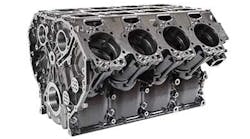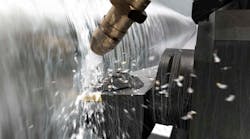Available products let shops take full advantage of all three.
The flute profile is critical for optimal chip formation and evacuation.
Three systems for deep-hole drilling include gun drill, ejector, and single tube.
KSEM drills from Kennametal feature a modular insert blade design that permits choice of insert grade. An insert-locking mechanism contained in the drill body prevents chip obstruction. Chips form on the carbide blade, not on the tool’s steel body, extending its life. This design is stable and accurate, even at high feedrates.
TwinGrade GC1030 from Sandvik is a PVD-coated compound grade drill that can double feedrates when drilling stainless steel on machine tools lacking the rigidity for high speed.
Solid carbide drills from Carboloy are self-centering and TiN coated by the PVD (physical vapor deposition) process for high performance and long tool life. Their edge design enhances chip control and evacuation in most workpiece materials including mild and alloy steels, stainless steels, cast iron, and nonferrous materials.
Guhring's Gurojet minimum lubrication system precisely delivers a fine air-coolant mist directly to the drill's cutting edge. The coolant mist travels externally or through internal coolant ducts in the drill.
A Guhring solid, ultra-fine carbide RT 100 high-penetration drill near-dry machines this cast iron part usingthe company's Gurojet system.
Holemaking, arguably the most basic of metalworking processes, is one area where shops can greatly improve returns on machine tool investments. It's easy to see how when one considers that 50 to 70% of all production time is spent making holes. Even small process improvements can boost production and drive down costs. However, the three holemaking techniques offering perhaps the greatest production gains are drilling more precise deep holes, drilling more holes in less time, and drilling dry.
These trends have spurred tooling manufactures to develop a host of new products. In addition, newer machine tools with greater rigidity, higher accuracy, and faster spindle speeds provide an impetus to the development and refinement of such drilling products. These products range from ejector-type systems for accurate deep-hole drilling to balanced tool-holders for high-performance drilling. They also include special tool materials and coatings for dry drilling.
Deep-hole drilling
Chipbreaking and removing chips — important in milling and turning — are also critical in drilling. The greater the hole depth, the more difficult it is to control the process and remove chips.
Originally, a deep hole was defined as one with a depth of five times its diameter or greater. Today, specialized deep-hole drilling systems easily handle large-diameter holes and lengths of more than 10 diameter. Many shops also produce holes with depths of more than 100 diameter. In addition, they demand high metal-removal rates along with accuracy regarding hole straightness, tolerances, and surface finishes.
To satisfy these demands, it is important that chips be broken and removed without jamming or damaging drilled surfaces. For deep-hole drilling, there are systems that both deliver cutting fluid to and transport chips away from the actual drilling site. Three of these are gun-drill systems, ejector systems (or double-tube systems DTS), and single-tube systems (STS).
The gun-drill system is designed to drill deep holes less than 3 /4-in. in diameter. It uses an old principle to supply cutting fluid to the drill tip. A duct in the drill delivers coolant to the cutting edge, after which a V-shaped chip flute along the outside of the drill tube removes chips. The drill portion consists of a carbide tip brazed to a shank.
While gun drilling provides excellent tool life, along with smooth surface finishes and straight holes, its main disadvantage is a slow feedrate due to poor tube strength.
The ejector system works well for hole-depth-to-diameter ratios of 50:1 or less and hole diameters of 3 /4 to 7 1 / 4 in. It has twin drill tubes, and cutting fluid is pumped in between the inner and outer tubes. While drilling, a major portion of the cutting fluid is led forward to the drill head, and the remainder is forced through a groove in the rear section of the inner tube. Negative pressure, arising in the front section of the inner tube, forces cutting fluid at the drill head, along with chips, out through the inner tube. For ejector systems, either brazed or indexable insert drills apply.
The self-contained systems adapt to most conventional machines, including both NC and CNC lathes. However, ejector systems produce short chips and require a rigid setup, a larger volume of coolant as compared to gun drilling, and special overload sensors.
STSs operate using an external cutting fluid supply and internal chip transport. With such a system, shops can drill holes smaller than what is possible with an ejector system. Cutting fluid travels between the drill tube and the drilled hole then exits, along with chips, through the drill tube. The velocity of the cutting fluid is so high that chips effort-lessly pass through the tube. This makes the STS ideal for drilling workpiece materials with poor chip-breaking qualities.
Since chip evacuation is internal, making chip flutes unnecessary, shanks are completely round to provide higher rigidity than with a gun-drill system. Tooling for an STS can include either brazed or indexable-insert drills.
"A primary advantage of STS over gun drilling is its higher productivity," points out Sandvik, Fair-lawn, N.J., senior product specialist Tony Yakamavich. "You might be able to penetrate at 1 or 2 ipm with gun drilling. With STS, 6 to 10 ipm is possible." Other advantages of an STS is that it delivers all the coolant to the cutting edge and goes over cross holes. However, STSs need more coolant volume and pressure than ejector systems, must run on dedicated machines, and require special overload sensors. Ejector systems drill faster than a gun drill and require less coolant and pressure than an STS.
High-performance drilling
Increasing productivity depends on a boost in drilling speed, penetration rate, or both. What constitutes as high-speed drilling can be somewhat arbitrary. Some drill manufacturers refer to high-speed drilling as drilling at spindle speeds fast enough for penetration rates 3 to 10 greater than those considered conventional. Others simply define high speed as drilling faster than usual.
Factors that affect drilling at slower speeds become more pronounced and critical as drilling speed or feedrates go up. Major considerations at high drilling speeds and feeds are heat, chip removal as the tool feeds deeper into the hole, and runout.
"As drilling feeds and speeds increase, the problem of providing sufficient coolant to remove the chips becomes more critical," points out Hank Bagadinski, Carboloy, Warren, Mich., product manager. "The volume of chips produced, if not removed, can cause chip jams, recutting, and high heat that shortens tool life. When you reduce cycle time by 90%, there is simply not much time to remove chips and a high pressure coolant flow is required. Many older machines do not have sufficient coolant to remove the chips, but in some cases, they can be retrofitted to increase coolant flow."
At lower speeds, HSS drills are often effective, providing a tool with relatively high bending strength and toughness. At higher speeds, though, carbide or even ceramic tools are necessary. These tool materials trade off some of the toughness of HSS for greater wear and heat resistance. Drill and holder balance also becomes critical at drill speeds exceeding 10,000 rpm. Shrink-to-fit and hydraulic toolholders are usually the choice for staying within acceptable out-of-balance limits.
However, older machine tools often have difficulty providing the concentricity necessary to take full advantage of today's new, precision drills. Total runout should be held to at least 0.001 in. While lathe drilling, with both the turret and chuck contributing to hole concentricity, runout at the tool should be no greater than about 0.0005 in.
Greg Pratte of Centaur Precision Tools Inc., Miami, Fla., points out the importance of toolholder accuracy. "Toolholders provide the link between the machine tool spindle and the cutting tool, and it must have the same rigidity and concentricity qualities as the spindle. For example, consider a coolant-fed, indexable drill with a 4-in. projection in a toolholding system that allows a maximum of 0.0002 in. within one inch of the toolholder face. The tip or cutting edges could runout over 0.001 in. Toolholders exist that can true the tip or cutting edge to within 0.0001 in. Such a toolholder can significantly improve tool life and workpiece accuracy at increased drilling speeds."
For high-speed drilling, toolmakers design products that prevent chips from coming into contact with a tool's cutting edges and flutes. Hot chips can soften and smear against the tool, filling in micro-scopic crevices in its edge surface. This built-up edge becomes the new cutting surface and may force the tool off center and lead to a failure. High-pressure coolant, delivered through the tool, can effectively flush hot chips away from the tool and out of the hole.
According to Chet Parzick of Kennametal, Latrobe, Pa., product manager on the company's Holemaking Team, coolant considerations at high speeds are critical, and the choice of coolant must match the material being drilled. For example, when drilling steel, the cooling effect is paramount, and when cutting aluminum, lubricity is key.
Most common, high-speed drills are made from a high-temperature grade of solid tungsten carbide. Where chatter may be a problem, a good choice is a tool made from a finer grade of carbide. Cutting tool manufacturers offer carbide grades with grain sizes of 0.5 µ or smaller, as compared to a more standard 2.5-µ grade. Carbide tools with smaller grains resist wear with less of a sacrifice in toughness.
Shops can also obtain solid-carbide drills with two grades of cemented carbide sintered together. The core is a tough, high-cobalt, high-strength grade for low-speed center performance, while the periphery is a harder, low-cobalt, wear-resistant grade for high-speeds. This design lets shops substantially increase penetration rates, especially for drilling stainless steel normally requiring low feedrates. High temperatures usually rule out using tools with steel bodies and brazed-on carbide tips because there is a danger of softening the braze that holds the tip to the tool body.
Although ceramic tools exhibit greater high-temperature hardness than carbide, they need to run on machine tools that can deliver sufficient speed and rigidity. Other tool materials exhibiting high wear resistance include polycrystalline diamond (PCD) and cubic boron nitride (CBN). However, these materials are expensive and, like ceramics, must run on high-performance machine tools.
Thin-film coatings can also significantly contribute to longer tool life, greater wear resistance, and faster operating speeds and feeds. Coatings increase surface hardness, reduce friction and heat buildup, and increase resistance to edge buildup, galling, and fissure propagation. Common coatings for high-speed drilling include TiN (titanium nitride), TiCN (titanium carbonitride), and TiAlN (titanium aluminum nitride).
TiN is a cost-effective, universally applicable coating that increases tool hardness to over 80 Rc. TiCN is a multilayer structure that inhibits surface fractures from propagating to the tool or the wear part substrate. It works best for machining hard materials and in high-shock applications such as interrupted drilling cuts. TiAlN provides extra hardness and heat resistance for machining such abrasive materials as cast iron and high-silicon-content aluminum alloys. This coating performs well in high thermal-stress conditions, such as in dry and near-dry machining along with deep and small-hole drilling where cutting fluids have difficulty penetrating.
In addition, proprietary coatings are available that manufacturers claim provide all the advantages of these three standard coatings. For example, combination coatings with a hard and soft layer can enhance machining capabilities. The soft layer, a lubricity coating, optimizes chip evacuation along the flutes and from the hole by eliminating edge build-up.
Near-dry/dry high-speed drilling
Although not as widespread in the U.S. as in Europe, interest in dry or near-dry drilling continues to increase (see "The 10 commandments of dry high-speed machining," and "Are you ready for Y2K tooling," AMERICAN MACHINIST, May 1998 and April 1999, respectively.) While exorbitant coolant and disposal costs are often cited as the reasons for the interest in Europe, others feel that the major benefit of dry machining is the elimination or simplification of coolant-management systems. "Dry drilling is attractive in the aircraft industry, for example, to minimize clean-up requirements," notes Kennametal'sParzick. "Contamination from coolant can be a major problem when drilling fastener holes in a wing section, which may also be a fuel tank."
High-speed and dry drilling have a lot in common. For both processes, the key is protecting the tool from heat. For machining with exposed edges (turning and milling), dry cutting is easier accomplished than in the enclosed confines of a drilled hole. When cutting edges are exposed, chips quickly leave the cutting zone and have little contact with the workpiece or the tool. Both remain relatively cool. But in drilling, cutting edges are subjected to high temperatures originating from the cutting process and hot chips.
Coolant is important in all aspects of drilling, and many feel that dry drilling is only effective for shallow holes, no deeper than 3 diameter in cast iron and no deeper than 1 diameter in hard steels and stainless. "My advice to anyone considering dry drilling is to carefully weigh the advantages versus the disadvantages," cautions Jack Burley, national product manager of rotating tools at KPT Kaiser, Elk Grove Village, Ill. "Coolant fed through the tool usually eliminates the need to peck when dry drilling holes of 2 to 2 1 / 2 in. in diameter. This is important because most tool wear occurs at the point of entry as the drill establishes cutting pressure. Thus, pecking is a major source of tool wear."
The effectiveness of dry drilling varies considerably from metal to metal, and cast iron is the material most often dry machined. Carbide is an applicable tool material for cutting dry. Ceramic tooling is also appropriate because it retains its hardness at high temperature and runs without coolant or lubricant. However, it can only be used with materials that will form small, easily managed chips. Ceramic tools are brittle and require close control of runout.
When eliminating a high-pressure coolant stream, some provision must be made for lubrication and chip removal. A soft lubricant coating, applied over the tool's hard coating, keeps hot chips from adhering to the tool and facilitates chip evacuation.
An alternative to completely dry machining is suspending an extremely small amount of coolant in a pressurized, air-coolant mist and directing it at the tool's cutting edge either as an external spray or through the tool. Flows of less than 1.7 oz/hr are typical, as compared to a flood-coolant flow of 1.6 gallon/min. Other, more expensive techniques for meeting dry-drilling requirements include chip suction systems, more efficient through-the-spindle minimum lubrication systems, and drilling upward so gravity removes chips.













